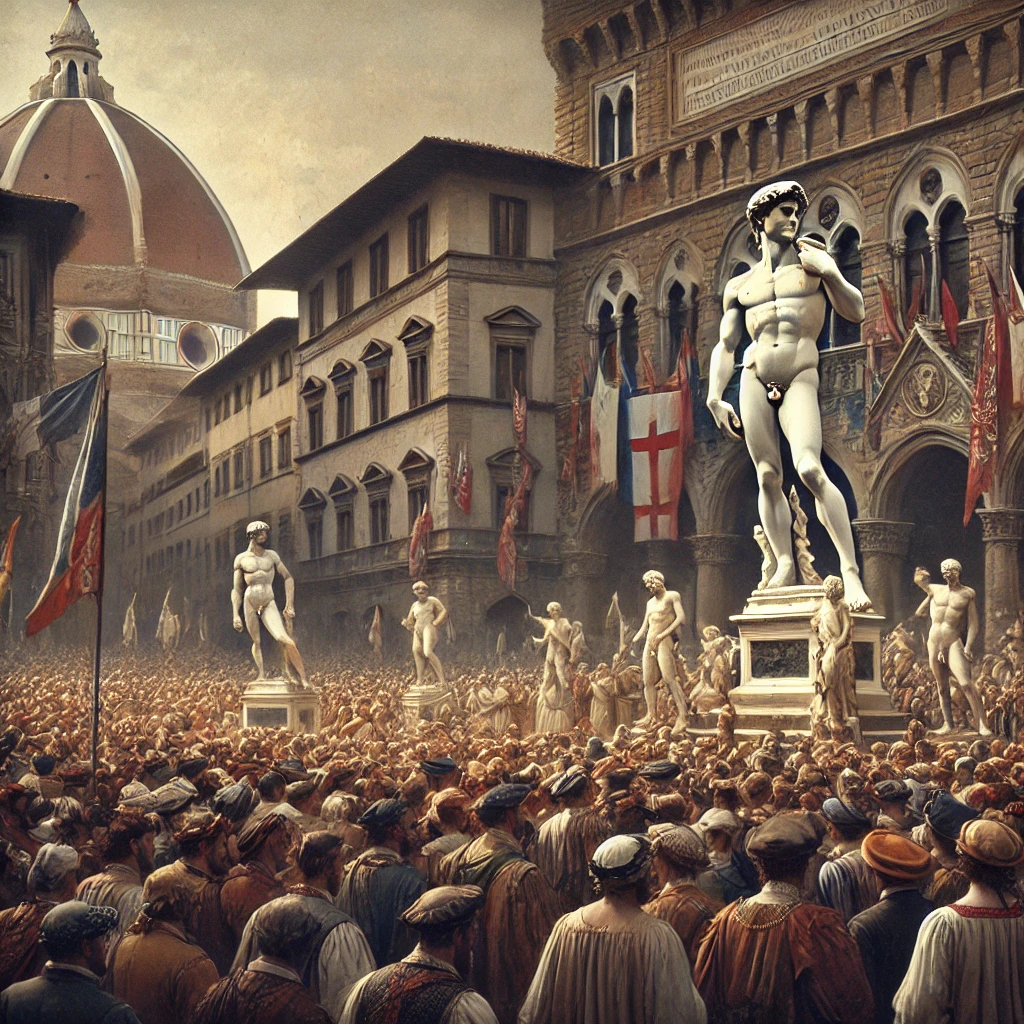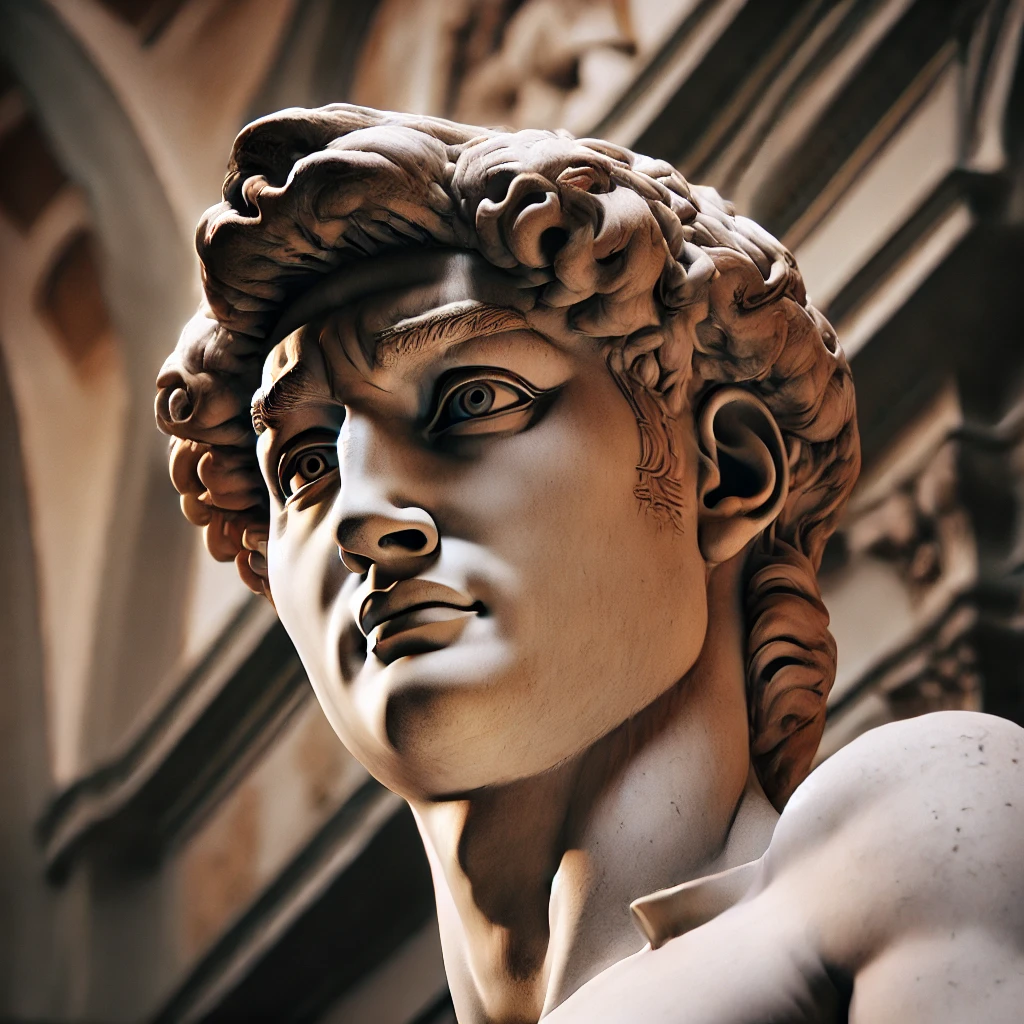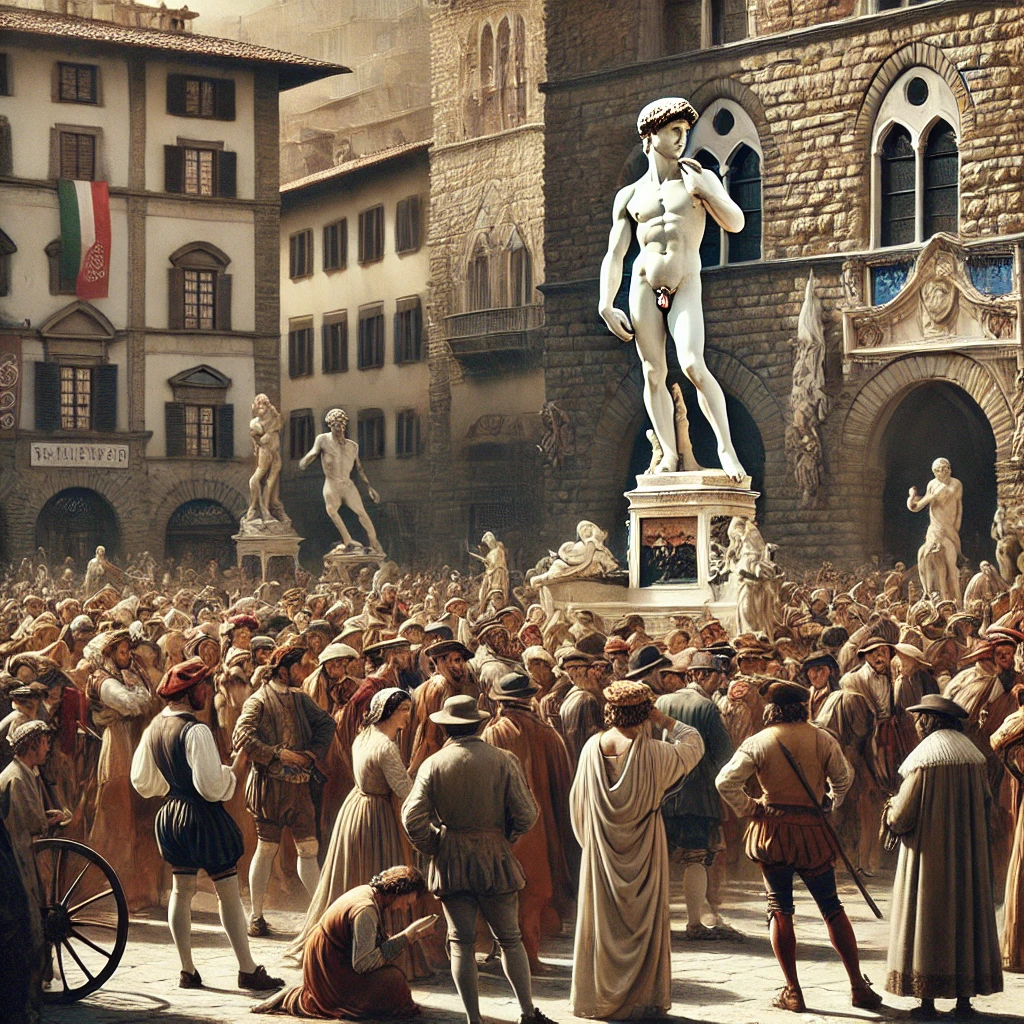On September 8th, 1504, the world witnessed the unveiling of one of the most iconic sculptures in art history—Michelangelo’s David. Standing at over 17 feet tall, this magnificent marble statue represents the biblical hero David, who defeated the giant Goliath with a single stone. Michelangelo’s David is not only a masterpiece of Renaissance art but also a symbol of human potential and a testament to the artistic genius of its creator.
The creation of David was a significant achievement in the context of the Renaissance, a period marked by a renewed interest in the classical ideals of beauty, proportion, and humanism. Michelangelo was commissioned to sculpt David by the Overseers of the Office of Works of the Florence Cathedral (Operai del Duomo) as part of a series of statues intended to adorn the cathedral’s exterior. The block of marble Michelangelo used had been abandoned by other artists due to its poor quality, but Michelangelo saw its potential and worked tirelessly for over two years to transform it into a work of art that would captivate the world.
The Unveiling in Florence
The unveiling of David in Florence was a momentous event. Originally intended to be placed high on the Florence Cathedral, the statue was so impressive that it was instead placed in a more prominent location, the Piazza della Signoria, in front of the Palazzo Vecchio, the seat of civic government in Florence. This decision underscored the importance of David not just as a religious symbol but as a representation of Florence’s civic pride and identity.
The statue’s placement in such a central location made it a symbol of the city’s strength and independence. Florence, during this period, was a powerful city-state often at odds with larger and more powerful neighbors. The figure of David, standing confident and ready to face his giant adversary, resonated with the Florentines as a metaphor for their own struggles and triumphs.

Michelangelo’s David: A Symbol of Humanism
David is more than just a representation of a biblical hero; it is a profound statement of Renaissance humanism. The sculpture embodies the Renaissance ideal of the perfect human form, with every muscle and vein meticulously rendered to reflect the beauty and strength of the human body. Michelangelo’s portrayal of David captures a moment of poised anticipation, just before his battle with Goliath, emphasizing the power of intellect and inner strength over brute force.
This emphasis on human potential and individual capability reflects the broader intellectual currents of the Renaissance. Humanism, a key movement of the period, sought to elevate the dignity and worth of the individual, focusing on the capacities of human reason and creativity. Michelangelo’s David became a symbol of these ideals, representing the belief that human beings have the power to shape their own destinies through intelligence, courage, and will.
Artistic Innovation and Influence
Michelangelo’s David stands out not only for its grandeur but also for its artistic innovation. The statue’s contrapposto stance, where the weight of the body is shifted onto one leg, creates a sense of dynamic movement and realism. This technique, borrowed from classical antiquity, was masterfully employed by Michelangelo to convey a lifelike quality that had rarely been seen in sculpture since ancient times.
The level of detail in David is also remarkable. Michelangelo’s ability to render the human anatomy with such precision set a new standard for artists of the time. The attention to detail, from the veins on David’s hands to the intense expression on his face, demonstrated Michelangelo’s deep understanding of the human body and his ability to infuse his work with emotional depth and realism.

The Cultural Impact of David
The unveiling of David had a profound impact on the art world and beyond. The statue quickly became a symbol of Renaissance ideals and was celebrated not only in Florence but throughout Italy and Europe. David was hailed as a masterpiece that embodied the artistic and intellectual achievements of the Renaissance, and it cemented Michelangelo’s reputation as one of the greatest artists of all time.
The influence of David extended beyond sculpture. It inspired artists in other mediums to pursue greater realism and emotional expression in their work. Painters, sculptors, and architects looked to Michelangelo’s David as a model of artistic excellence, and it helped to usher in a new era of creativity and innovation in the arts.
David as a Political Symbol
Beyond its artistic significance, David also played a political role in the history of Florence. As a symbol of the city’s defiance and independence, the statue was often invoked in times of political conflict. During the turbulent years of the early 16th century, when Florence faced threats from external powers and internal strife, David stood as a reminder of the city’s resilience and strength.
The statue’s symbolism was not lost on the citizens of Florence, who saw in David a reflection of their own struggle against larger, more powerful forces. This connection between the statue and the city’s identity helped to solidify David’s place in the cultural and political life of Florence, making it a symbol not only of artistic achievement but also of civic pride.
The Legacy of Michelangelo’s David
Today, Michelangelo’s David is recognized as one of the most important works of art in the world. Its influence on the development of Western art is immeasurable, and it continues to be celebrated for its technical brilliance and profound symbolic meaning. The statue remains a central attraction in Florence, drawing millions of visitors each year to admire its beauty and contemplate its significance.
David’s legacy also extends to its impact on the broader cultural landscape. The statue has been referenced in literature, film, and popular culture, and it continues to inspire new generations of artists and thinkers. As a symbol of human potential, resilience, and creativity, David resonates as strongly today as it did when it was first unveiled over 500 years ago.

A Masterpiece for the Ages
The unveiling of Michelangelo’s David on September 8th, 1504, was a defining moment in the history of art and a milestone in the cultural development of the Renaissance. The statue’s importance in world history lies not only in its artistic innovation but also in its embodiment of the ideals of humanism, civic pride, and intellectual achievement.
As a masterpiece that has transcended its time and place, David continues to inspire awe and admiration. Its enduring legacy is a testament to the power of art to capture the human experience and to shape our understanding of beauty, strength, and the potential of the human spirit. Michelangelo’s David remains one of the greatest works of art ever created, a symbol of the Renaissance and a beacon of human achievement.
